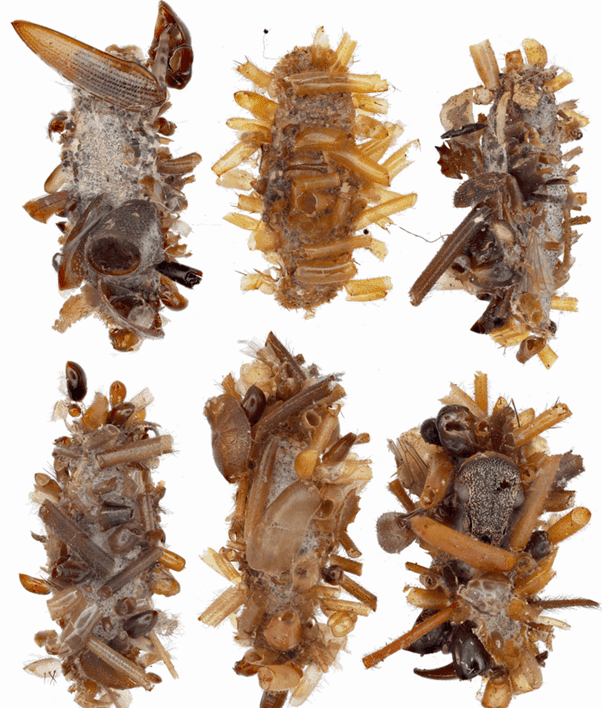Extraordinary behavior has been reported in a species of Hyposmocoma caterpillars. Although the species is yet to be given a scientific name, the team that discovered its behavior call it the “bone collector” caterpillar for the way it will wear pieces of its prey’s bodies as if as trophies.
Children’s books are not always the best source of scientific information, but the generations who read The Very Hungry Caterpillar got the correct message that prior to metamorphosis, butterflies and moths are predominantly vegetarian. When you’re not built for speed, it’s best to make your diet from things that can’t run away.
Despite this, a few hundred caterpillar species out of the 200,000 known Lepidoptera species eat other insects, sometimes even their own kind. Carnivory is relatively common in Hawai’ian caterpillars, where isolation has caused invertebrates to do some truly strange things, and one caterpillar even hunts snails.
Carnivory is one thing, psychopathic terror induction is another. Yet on the island of Oa’hu, University of Hawai’i entomologists have discovered a previously unknown species that seems to have been taking lessons not so much from serial killers, but horror writers’ implausible depictions of serial killers.
Bone killer caterpillars consume dead or dying insects, and then strew the inedible body parts of their prey on the silk cases they carry with them. Victims have been identified from six families of insects, and it’s likely any suitably sized arthropod would be gobbled up. Perhaps the sight of the limb-encrusted caterpillars cause potential victims to die of sheer terror, but it might be expected such trophies would not only slow the caterpillars down, but also ensure potential food gave them a wide birth.
Perhaps for these reasons, no other known insect has adopted this behavior, but that’s not a huge problem for the bone collectors. Instead of catching their own prey, they live entirely within or near spider webs, at least during the larval stage. Bone collectors feed on a mix of insects trapped by the web they get to before the spider, and those the web-owner has wrapped up to eat later, like Shelob did to Frodo (sorry, not linking to that scene – find it yourself if you like).
The authors report that bone collectors don’t just casually throw on bits and pieces of prey, instead carefully measuring and selecting those that suit their needs and adjusting placement for maximum impact. Oversized insect limbs will be chewed down until they fit. On the other hand, when the authors denied the caterpillars access to suitable body parts, but offered them leaves and bits of wood instead, non-gruesome alternatives were rejected.

Examples of six bone collector caterpillars and the trophies they wear.
Image credit: University of Hawai’i
This costume may work as a “don’t mess with me” for rival caterpillars, plausibly since bone collectors have been observed to engage in cannibalism in captivity. However, since they’ve never been observed two to a web, the authors think the most likely explanation is that wearing all these body parts serves to camouflage bone collectors from the spider in whose web they live.
Authors Professor Daniel Rubinoff, Dr Michael San Jose, and Dr Camiel Doorenweerd explain that over 22 years of fieldwork, only 62 bone collectors have been seen, all within a 15-square-kilometer (6-square-miles) area of forest. They therefore consider them to be at great risk of extinction, although the authors note the species has survived one threat by adapting to the webs of introduced spiders that have displaced the native species.
As with many island eccentrics, bone collectors may not long survive rapidly changing ecosystems as the world comes to Hawai’i. “Conservation action to save this globally unique lineage is imperative and overdue,” the authors write.

The beauty of the island on which it lives provides a welcome contrast to the horrors of the caterpillar.
Image credit: University of Hawai’i
Remarkably, the authors conclude the bone collector has been doing its thing for millions of years, having broken away from its nearest relatives at least six million years ago. Indeed, they think it’s much older than the island on which it lives, or indeed any of the surviving Hawai’ian Islands, the oldest of which is thought to have formed 5 million years ago. Bone collectors must have evolved, therefore, on islands that have now eroded into the sea, hopping from one island to another in that time.
By describing the behavior before publishing a detailed scientific description of the species, the authors have passed up the opportunity to name their find, at least for now. That, however, opens up the opportunity for everyone else to suggest the most appropriate nightmare to get the honor.
The study is published in Science.
Source Link: Newly Discovered “Bone Collector” Caterpillar Wears The Bodies Of Its Prey Like A Serial Killer